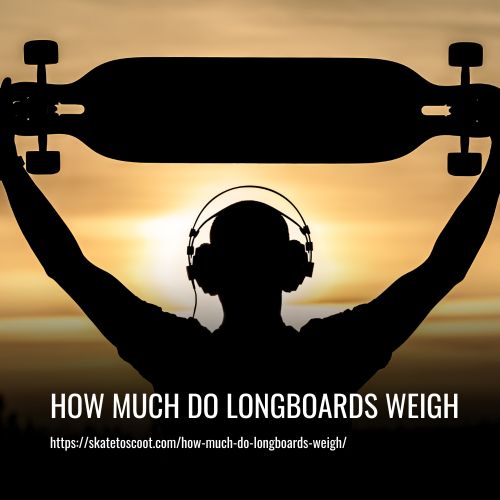As an Amazon Associate we earn from qualifying purchases.
The average weight of a longboard can vary depending on various factors such as the size, material, and purpose of the board. Typically, most longboards weigh between 4 and 10 pounds (1.8 – 4.5 kg). This range is common for traditional longboards made from materials like wood or epoxy.
However, it is important to note that there are exceptions to this range. For instance, mini cruisers or longboards designed for kids may weigh as little as 3 pounds (1.4 kg), making them easier to handle for younger riders. On the other hand, electric longboards, which are equipped with motors and batteries, can weigh up to 15 pounds (6.8 kg) to accommodate the additional components.
When selecting a longboard, riders should consider their own preferences and riding style. Experienced surfers might opt for a lighter board, as it offers more maneuverability and responsiveness in the waves. Conversely, a heavier board might be preferred by beginner surfers or those looking for stability and control. Additionally, larger boards tend to be heavier than shorter ones due to their increased surface area.

Factors that impact the weight of longboards.
When it comes to longboards, the weight of the board can greatly impact the riding experience. Several factors contribute to the overall weight of a longboard, and understanding these factors can help riders make an informed decision when choosing the right board for their needs. Here are the key factors that affect longboard weight:
1. Longboard Material:
The material used to construct the longboard is one of the biggest factors determining its weight. Longboards can be made from various materials such as wood, plastic, and carbon fiber. As a general rule, lighter materials like carbon fiber and plastic result in a lighter longboard. These lightweight options offer enhanced maneuverability and responsiveness for experienced surfers. However, if you prefer a more traditional feel and don’t mind a bit of extra weight, a wooden longboard may be a suitable choice.
2. Longboard Size:
The size of the longboard is another crucial factor influencing its weight. Larger longboards tend to be heavier due to their increased surface area. If you prioritize having a lightweight board, opting for a smaller size is recommended. Conversely, if you are a heavier rider or desire a board with increased stability, a larger longboard might be more suitable.
3. Type of Longboard:
The type of longboard also affects its weight. Different designs and shapes have varying weights. For example, a traditional pintail longboard is generally lighter compared to a drop-through longboard. When selecting between different types of longboards, weight can be a contributing factor to consider alongside other preferences and riding style.
4. Special Features:
Some longboards may have extra features that could increase their weight. Longboards that have LED lights or built-in speakers may be heavier than basic ones. It is important to consider if these features are necessary for your riding experience, as they can add to the overall weight.
What are some methods for decreasing the weight of a longboard?
If you are looking to reduce the weight of your longboard, there are a few things that you can do. Here are some tips to help you lighten your longboard without compromising on quality or performance:
1. Choose a Lighter Board:
One option is to choose a lighter board in the first place. Consider materials like carbon fiber or plastic, as they tend to be lighter compared to wood. These lightweight options offer enhanced maneuverability and responsiveness for experienced surfers.
2. Optimize Your Trucks and Wheels:
Make sure that you have the right trucks and wheels for your board. High-quality trucks made from lightweight materials such as aluminum can significantly reduce the overall weight of your longboard. Similarly, lighter wheels made from urethane or other lightweight materials can contribute to a lighter setup.
3. Use Risers:
Another way to reduce the weight of your longboard is by using risers. Risers are inserts placed between the trucks and the deck to raise the height of the board. By using thinner or lighter risers, you can minimize unnecessary weight and make your longboard lighter.
By following these steps, you can reduce the weight of your longboard and enhance your riding experience. Remember to consider your riding style and preferences when making any modifications to your board. Enjoy a lighter and more agile ride with these weight-reducing techniques.
Here are some tips for selecting a lightweight longboard.
When it comes to choosing a longboard, it’s important to consider its weight. A lightweight longboard can offer enhanced maneuverability and make it easier to transport. Here are some tips to help you choose a lightweight longboard that suits your needs:
1. Determine Your Riding Needs:
Before making a purchase, clarify the purpose of your longboard. Are you planning to use it for commuting, downhill racing, freestyle tricks, or something else? Knowing your intended use will help you narrow down your options.
2. Look for Material:
Consider longboards made from lightweight materials like bamboo. Bamboo is not only strong, but it’s also lightweight, making it easier to carry around while still maintaining durability.
3. Choose the Right Deck:
The deck of a longboard is essential for stability and maneuverability. Look for a deck that is wide enough to provide stability while riding but not so wide that it becomes difficult to maneuver. This balance will help you achieve the desired lightweight feel without sacrificing performance.
4. Pay Attention to Trucks and Wheels:
The trucks are responsible for connecting the wheels to the deck, so you’ll want to choose high-quality and durable trucks. This will not only contribute to the overall weight of the longboard but also ensure stability and control while riding. Additionally, opt for wheels that have excellent grip on the pavement to enhance safety during your rides.
Advantages and disadvantages of a lightweight longboard?
When considering a longboard, it’s important to think about the weight and how it can impact your riding experience. Choosing a lightweight longboard has its pros and cons. Let’s take a closer look at them:
Advantages:
- Easier to Carry: A lighter longboard is easier to transport, especially if you need to carry it for longer distances or up and down stairs. This makes it more convenient for commuting or traveling with your board.
- Increased Maneuverability: With less weight to maneuver, a lightweight longboard offers enhanced agility and responsiveness. It allows for quick turns, easier tricks, and more control while riding.
- Faster Speed: Lighter longboards tend to have less drag, allowing you to achieve higher speeds with less effort. This can be advantageous for downhill racing or cruising on flat surfaces.
- Comfortable for Longer Rides: Carrying less weight under your feet can have a positive impact on your comfort during longer rides or sessions. It reduces fatigue and allows you to enjoy your ride for extended periods.
- Lower Risk of Injury: In the unfortunate event of a fall, a lighter longboard is less likely to cause severe injury since it exerts less force upon impact.
Disadvantages:
- Reduced Durability: Lightweight longboards are often made from less durable materials than heavier boards. They may not withstand as much wear and tear over time, requiring more frequent repairs or replacements.
- Weight Limitations: If you’re a heavier rider or plan to carry additional weight on your board, a lightweight longboard may not be suitable. It may lack the necessary strength and stability to handle heavier loads.
- Limited Riding Styles: Lightweight longboards are better suited for certain riding styles, such as cruising and freestyle tricks. They may not perform as well in more aggressive or high-impact disciplines like downhill racing or large wave surfing.
Considering these pros and cons will help you make an informed decision about whether a lightweight longboard is right for you. Ultimately, it’s important to find the balance between weight, durability, and performance that best suits your riding preferences and needs.
FAQs
Longboards are a popular choice for experienced surfers and riders who are looking for a smooth and stable ride. One common question that often comes up is, how much do longboards weigh? The weight of a longboard can vary depending on various factors, such as the type of board, size, and materials used.
On average, a longboard weighs between 11 to 14 pounds. To break it down further, the weight distribution of a standard longboard consists of the following components:
The weight of longboards can vary depending on several factors.
The weight of a longboard is influenced by factors such as board shape, size, and materials used.
Generally, shorter boards tend to be lighter than larger boards. Additionally, boards with a wider deck are often heavier due to the increased surface area.
Yes, as a rule of thumb, larger boards tend to be heavier than smaller ones.
Longboards made from lightweight materials such as carbon fiber or epoxy are typically lighter than those made from traditional materials like foam.
Experienced surfers may prefer slightly heavier boards as they often offer greater stability and control.
Yes, the weight of a longboard does matter, especially when it comes to stability and performance. Factors such as the size and shape of the longboard can affect how much weight it can withstand. As a general rule of thumb, larger longboards are better suited for stability and can handle more weight compared to shorter boards.
If you are a heavier rider or prefer a more stable ride, it is recommended to choose a longboard with a wider deck and a larger size. Longboards with widths between 7 to 9 inches are usually suitable for riders weighing between 200 to 250 pounds.
Conclusion:
The weight of a longboard may seem like a small detail, but it can make a big difference in your riding experience. Whether you prefer a lightweight board for tricks and agility, or a heavier one for stability and control, finding the right weight for you is crucial.
So, next time you hit the streets or the skate park, remember to consider the weight of your longboard and choose the one that suits your style and preferences. Happy riding!
Amazon and the Amazon logo are trademarks of Amazon.com, Inc, or its affiliates.



